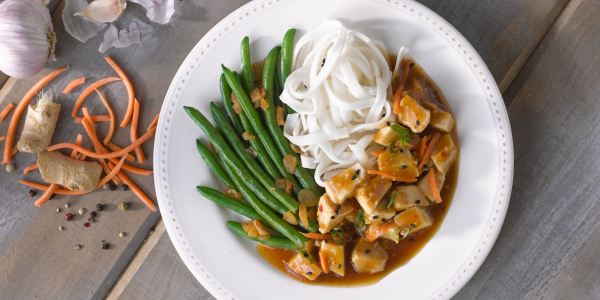
Wondering about white meat vs dark meat? Whether trying to decide once a year while reaching for Thanksgiving turkey or every day when you're dishing up lean protein like chicken for lunch, understanding the answer to this common conundrum can help you decide what's best for you and your health.
Spoiler alert! Both white and dark meats have their place in a healthy diet, and white meat doesn't have to be bland and boring.
Exhibit A: bistroMD's tasty (and healthy) chicken recipes bursting with flavor!
Read on to discover the differences between dark meat vs white meat chicken, turkey, and other types of poultry.
White Meat vs Dark Meat Chicken
It's tempting to divide white, dark, and red meats into categories purely based on color. Some scientific studies even categorize fish as "white meat" mainly based on its light color. However, judging meat purely based on its hue can be misleading, especially once cooking processes come into play.
While the color of the meat plays a role, whether the meat is white or dark largely depends on the part of the chicken (or other type of poultry) it comes from. Keep reading to understand what specifications go into categorizing different types of meat as white or dark—and distinctions that can help you understand the differences and decide what's best for your health.
White Meat Chicken Specs
White meat is also known as light meat due to its pale appearance. Although there are more technical specifications, it's generally the palest, whitest meat of a bird or other animal—sometimes pork or veal can be categorized as white meat. This type of meat often retains its lighter color when cooked.
Location
Coming from breast and wing cuts of chicken or turkey, white meat has a lighter color due to a lower amount of myoglobin—a protein found in muscles.
The white fibers found in these thicker areas of the animal's body are also known as fast-twitch fibers. When the bird is alive, they help to provide a quick burst of energy for activities like flight.
Texture & Flavor
Unlike dark meat, white meat coming from white muscle fibers doesn't store much fat. Since fats provide some lubrication, white meat tends to be a bit dryer in texture than dark meat.
Generally, white meat is considered less flavorful than dark meat. For some individuals, this is a perk since the dryer meat is seen as a more neutral base for other flavors and seasonings.
Nutrition
As mentioned above, white meat doesn't have as high-fat content as dark meat. Since fats account for more calories (9 calories per gram) than protein (4 calories per gram), white meat contributes fewer calories to a meal.
White meat, such as from the breast of a turkey rather than the thigh, tends to contain more protein. Regarding micronutrients, white meat tends to rate lower than dark meat, except for more phosphorus and vitamins B3 and B6.
Dark Meat Chicken Specs
As implied by its name, dark meat has a darker color. Although it's often misunderstood, dark meat has a nutrient profile that may provide unique benefits depending on your health goals.
Location
Generally, dark meat is located in the legs and thighs of fowl used for food. For example, a chicken thigh would technically qualify as dark meat—even if it's lighter in color. Although color differences may seem hardly noticeable, especially in some varieties of cooked birds, there are structural differences in the meat at the cellular level.
The muscle fibers in this body region contain more compound myoglobin, lending a darker color to the meat than you would find in the breast or wings. Interestingly, it's believed that the more rich concentration of myoglobin in these muscles is due to all the walking chickens and turkeys do!
Texture & Flavor
Dark meat is well-loved due to its fattier flavor and tender texture. It's also naturally juicier than white meat, thanks to its ability to retain moisture. From chicken to turkey to duck, both home cooks and culinary chefs use dark meat for everything from comfort food and elevated cooking.
If you're intimidated by dark meat and don't quite know what flavors to pair with it, chicken thighs are a great place to start. They can be cooked in similar ways to light meat chicken breast.
Nutrition
Since the muscles in this part of the animal also act as an energy storage system, dark meat contains extra fat that the poultry may need to convert into energy. For this reason, dark meat tends to have a higher calorie and fat content than white meat of the same portion size.
Luckily, the fat contained in dark meat is a mix of saturated and unsaturated, meaning there’s still plenty of healthful fats involved. Sodium levels are also marginally higher in cuts of dark meat.
However, dark meat also tends to contain higher levels of other important vitamins and minerals, such as:
•B-vitamins, including riboflavin, thiamine, and vitamin B12
•Iron
•Selenium
•Zinc
Is Dark or White Meat Chicken Healthier?
Since dark meat technically has a higher fat content, it's often considered the less healthy of the two types of meat. However, white and dark meat can be served as part of a healthy plate, contain nearly the same amount of protein, and provide essential nutrients to the diet.
Other factors, like species, animal age, breed, living environment, and feed type may also influence the overall nutrient content—regardless of whether the meat is light or dark. For example, older birds may have more myoglobin content in their meat. Animals who eat diets primarily made of wheat may have lighter-colored meat.
Your health goals can help to inform your choice between white and dark meat, as well as choosing between distinctions like cage-free, grain-free, pasture-raised, or grass-fed. For example, eating an excessive amount of saturated ("unhealthy") fats can be a contributing factor to serious diseases, such as type 2 diabetes and cardiovascular disease. Individuals facing these diagnoses may want to opt for white meat when possible.
If you're unsure if these distinctions matter for you individually, you can always work with a dietitian to help you decide.
The bottom line is that both dark and light meat can be a healthy choice, and both contain plenty of nutrients—even though dark meat has traditionally been vilified. At the end of the day, the choice between white and dark meat often comes down to other factors, including flavor and texture preferences.
Culinary Use
Culinary and cooking methods also play a role in the healthfulness of white and dark meat. For example, while both a skinless chicken breast and a breaded chicken breast used on a sandwich may both be white meat, the skinless option is considered "healthier"—breading often adds excess calories or fats without much nutritional value. Poultry skin also contains added calories and fat, and removing it can instantly make your chicken or turkey dish more healthy.
Even though dark meat is usually seen as the less healthy option, there are healthy ways to prepare and cook it that preserve its nutritional value. When eating dark meat, you can opt for a smaller serving size to keep calories and fat to a manageable level. Carefully consider the type of bird, too. Surprisingly, dark turkey meat has fewer calories and grams of fat than a dark meat chicken, such as a chicken thigh.
Regardless of the type of meat, it’s important to cook with healthy fats (like olive oil) to add unsaturated ("healthy") fats to the meal. Some types of poultry have salt added during processing, so be sure to look at the label for additives.
It’s also advised to cook at appropriate temperatures for food safety and to avoid the development of carcinogenic compounds that can occur at high temperatures. In general, grilled or baked meats are healthier than breaded or fried.
Feeling overwhelmed by all your options? For a healthy and sensible solution, bistroMD offers both white and dark meat meals. Since they are doctor-designed and chef-prepared, you won't have to worry about which meat is healthier at each meal. Instead, perfectly-balanced meals will provide the nutrients you need to work towards your health goals!
The Conclusion on White Meat vs Dark Meat Chicken
When choosing between light or dark meat poultry, both can have health benefits. For the calorie-conscious, white meat with less fat and more protein may be the better option. However, dark meat may contain marginally more vitamins and minerals and is well-loved for its tender texture and melt-in-your-mouth flavor.
References:
Hughes JM, Clarke FM, Purslow PP, Warner RD. Meat color is determined not only by chromatic heme pigments but also by the physical structure and achromatic light scattering properties of the muscle. Compr Rev Food Sci Food Saf. 2019;19(1):44-63.
Klemm S. Breasts vs Thighs Which Is More Nutritious. Eatright.org. Published March 2021.
Reinagel M. Color Confusion: Identifying Red Meat and White Meat. Foodandnutrition.org. Published January 2013.
Soren, N. M., & Biswas, A. K. (2020). Methods for nutritional quality analysis of meat. In N. M. Soren & A. K. Biswas (Eds.), Meat Quality Analysis: Advanced evaluation methods, techniques, and technologies (pp. 21-36). Academic Press.
White DA. Is White Meat Really the Healthiest Part of the Turkey? Foodnetwork.com. Published November 2022.
Wideman N, O’Bryan CA, Crandall PG. Factors affecting poultry meat colour and consumer preferences. Worlds Poult Sci J. 2016;72:353-366.







